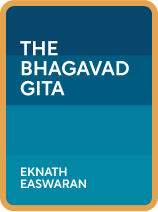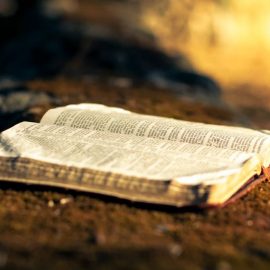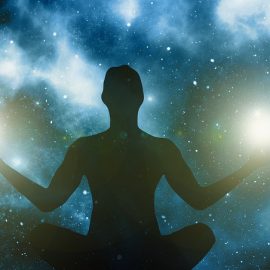

This article is an excerpt from the Shortform book guide to "The Bhagavad Gita" by Eknath Easwaran. Shortform has the world's best summaries and analyses of books you should be reading.
Like this article? Sign up for a free trial here .
Are you looking for a Bhagavad Gita glossary? What are the important words, terms, and people you need to know to read the Bhagavad Gita?
This Bhagavad Gita glossary will help you understand key terminology and people. It’s important as you read to keep track of definitions and meanings. of terms, as well as the characters and gods who are mentioned, which is what this Bhagavad Gita glossary can help you do.
Keep reading for a complete Bhagavad Gita glossary.
Bhagavad Gita Glossary
This Bhagavad Gita glossary covers major terms, people and more. It is presented in alphabetical order for ease of use.
You can use this Bhagavad Gita glossary as you read, or to reference terms in research.
Ahamkara: Self-will, or egoism. Ahamkara deludes people into seeing themselves as individuals in charge of their own fates, rather than as tiny parts of the infinite divinity.
Akasha: The element of sky, or space. The void in between planets and stars. Akasha fills the universe, but is not affected by it.
Arjuna: One of Pandu’s children. Arjuna is a prince, the leader of the Pandavas, and the protagonist of the Gita. Most of the text is Krishna answering Arjuna’s question and teaching him how to free himself from karma and reincarnation.
Atman: The “soul,” or the true self. However, it’s not confined to a single person’s soul as western cultures would think of it; Atman is a pervasive, universal force of creation and life. The part of Atman that resides in the body is called Purusha.
Bhagavad Gita: “The song of God.” Krishna is an incarnation of the god Vishnu, and the Gita is his “song,” the lessons he teaches to Prince Arjuna.
Brahma: The creator deity in Hinduism. Like Vishnu, Brahma is a manifestation of the eternal Brahman.
Brahman: The ultimate truth and power of the universe, and Vishnu’s highest form. Brahman is found in everything that exists, and the universe runs according to its laws. It is represented by the syllable om.
Brahmin: The highest caste in Hindu culture. Brahmins are typically called to be priests, teachers, or wise men.
Buddhi: Intellect and reason, also ideas and purpose.
Deva: Minor deities in Hindu mythology who take care of the world.
Dharma: Sometimes translated as “law” or “duty,” it refers both to the universal laws as set down by the gods and an individual’s personal destiny.
Dhritarashtra: The king of the Kauravas, who are the villains of the Bhagavad Gita.
Duryodhana: The eldest son of King Dhritarashtra. The greatest enemy of Prince Arjuna, Krishna, and the Pandavas.
Guna: ”Attribute” or “quality.” There are three gunas: sattva, rajas, and tamas.
Karma: The cosmic force that binds people to the cycle of reincarnation, and determines what they will be reborn as. Every action that a living being takes adds to its karma, whether good or bad. Breaking free of karma is the ultimate goal of Hinduism.
Kauravas: Meaning “the children of Kuru.” The Kauravas are seen as the villains of the battle, wicked usurpers trying to overthrow the Pandavas.
Krishna: One of the incarnations of the god Vishnu, and considered to be a god in his own right.
Kshatriya: The second-highest caste, the warriors and leaders. Arjuna is a kshatriya.
Kurukshetra: The field where the great battle of the Mahabharata occurs. It’s located to the north of modern-day Delhi.
Manas: The mind, and more specifically the memory.
Maya: “Magic” or illusion. The power of the gods to deceive mortals with temporary creations. Krishna reveals that he’s taken his current mortal form through the power of his maya.
Pandavas: Meaning “the children of Pandu,” this term refers to Prince Arjuna and his four brothers. The Pandavas are seen as the heroes of the battle, the rightful rulers of the kingdom of Hastinapura, who stand against the wicked Kauravas.
Prakriti: The physical body, mind, emotions, and sense of self. In short, everything except the Purusha.
Purusha: Soul. The immortal spirit, also called adhidaiva. The true self that is reborn into many different bodies.
Rajas: The guna of passion and anger. Rajas often drives great actions, but inevitably binds the one doing them to karma.
Samsara: The cycle of death and rebirth.
Sannyasa: The complete renunciation of action as a means to free oneself from karma.
Sattva: The guna of wisdom, creation, and harmony. The only one of the three that is desirable.
Sense-object: Anything experienced by the body or the mind. This includes physical objects, experiences, and emotions. Sense-objects are temporary, and therefore—according to Krishna—not real.
Shraddha: Roughly translated as faith, though that doesn’t fully capture the scope of what shraddha is. It could be seen as the sum of all the beliefs that a person holds in his or her heart.
Tamas: The guna of darkness, destruction, and depression.
Tyaga: Renunciation of the results of one’s actions. Unlike sannyasa, this still allows for actions to be taken; however, instead of acting for personal gain, you devote each action to God. Since the one practicing tyaga isn’t bound by the results of his or her actions, this is another way to break free of karma.
Vishnu: One of the three supreme deities of Hinduism; the god of creation and life. Whenever the world is threatened with chaos or imbalance, Vishnu comes to Earth in a physical incarnation. Krishna is one such incarnation.
Keep this Bhagavad Gita glossary handy for your reading.

———End of Preview———
Like what you just read? Read the rest of the world's best book summary and analysis of Eknath Easwaran's "The Bhagavad Gita" at Shortform .
Here's what you'll find in our full The Bhagavad Gita summary :
- The key principles of the Hindu faith
- Why all spirituality is good and there is no single path to God
- The 3 reasons that can explain every action people take






